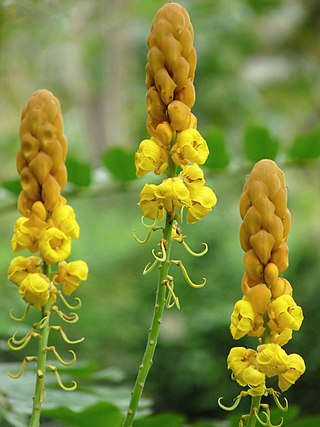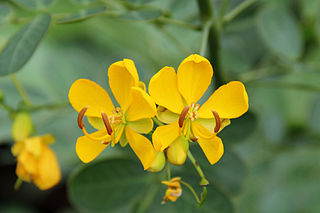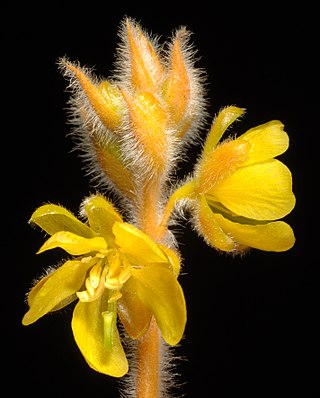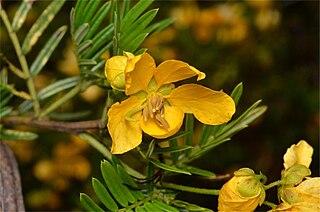
Senna spectabilis is a plant species of the legume family (Fabaceae) in the subfamily Caesalpinioideae native to South and Central America. They are often grown as an ornamental in front yards, parks, gardens, buildings etc. due to their bright yellow flowers that bloom during the summer months. They are also known as golden wonder tree, American cassia, popcorn tree, Cassia excelsa, golden shower tree or Archibald's cassia.

Senna alata is an important medicinal tree, as well as an ornamental flowering plant in the subfamily Caesalpinioideae. It also known as emperor's candlesticks, candle bush, candelabra bush, Christmas candles, empress candle plant, ringworm shrub, or candletree. A remarkable species of Senna, it was sometimes separated in its own genus, Herpetica.

Senna bicapsularis is a species of the legume genus Senna, native to northern South America, from Panama south to Venezuela and Colombia, and also the West Indies. Common names include rambling senna, winter cassia, Christmas bush, money bush, and yellow candlewood. In Florida, Senna pendula is usually cultivated as, and misapplied to, S. bicapsularis.

Senna gaudichaudii, also known by many common names, including kolomana in Hawaii and as blunt-leaved senna in Australia, is a species of flowering plant in the family Fabaceae and is native to some Pacific Islands including Hawaii, parts of Southeast Asia and Queensland in Australia. It is shrub or small tree with pinnate leaves, usually with three to five pairs of oblong to egg-shaped leaflets, and yellow flowers arranged in groups of four to ten, with ten fertile stamens in each flower.

Senna armata is a species of flowering plant in the legume family known by the common names spiny senna and desert senna. It is native to the desert regions around the intersection of Nevada, Arizona, eastern California and northern Baja California, where it grows in sandy and rocky habitat, such as arroyos. It is a shrub growing up to a meter tall, its grooved, branching stems often narrowing to thorns at their tips. The spiny branches are coated in tubular hairs which help protect it from hot desert air. The spine-tipped leaves are each made up of two to four pairs of small leaflets. The leaves are ephemeral, dropping soon after emerging, leaving the shrub naked most of the time. Flowers occur singly or in small clusters in leaf axils. They are fragrant and showy, with five petals in shades of yellow to salmon pink, each measuring roughly a centimeter long. The fruit is a legume pod up to 4 centimeters long.

Senna didymobotrya is a species of flowering plant in the legume family known by the common names African senna, popcorn senna, candelabra tree, and peanut butter cassia. It is native to Africa, where it can be found across the continent in several types of habitats.

Senna multiglandulosa, commonly known as glandular senna, downy senna, or buttercup bush is a species of flowering plant in the family Fabaceae and is native to Mexico, Guatemala, and western parts of South America. It is a shrub with pinnate leaves, usually with six to eight pairs of linear to lance-shaped leaflets, and yellow flowers arranged in groups of ten to twenty, with seven fertile stamens in each flower. It is widely cultivated as an ornamental plant and in some areas of the world has become naturalized.

Senna septemtrionalis, commonly known as arsenic bush, is a species of flowering plant in the family Fabaceae and is native to Central America, the southern United States and Mexico, but is naturalised in many other countries. It is an erect shrub with pinnate leaves, with four or five pairs of egg-shaped leaflets, and yellow flowers arranged in groups of five to eight, usually with seven fertile stamens and four staminodes in each flower.

Senna italica, the Port Royal senna, Italian senna, or Senegal senna is a legume tree in the genus Senna. It is recognized by many other common names based on the regions it grows in. In India, it is used to produce a powder for treating hair-related diseases which is known as “neutral henna”. Whereas, in some parts of the world, this species is cultivated for the leaves which yield the drug senna, known commonly as Senna glycoside, which in turn is the base for a laxative. Senegal senna is easily distinguishable through its many distinctive features. There are 3 subspecies of this plant based on the size of the inflorescence and the length of the petiole. The subspecies are italica, micrantha, and arachoides. In many regions, this plant is cultivated commercially and medicinally.

Senna acclinis, commonly known as rainforest cassia or brush senna, is a species of flowering plant in the family Fabaceae and is endemic to near-coastal areas of eastern Australia. It is a shrub with pinnate leaves and bright golden yellow flowers in groups of two to five and long, narrow seed pods. It is similar to other species of Senna that are environmental weeds.

Senna surattensis, also called glossy shower, scrambled egg tree, glossy shower, golden Senna, glaucous Cassia, sunshine tree and bushy Cassia, is a plant species of the legume family (Fabaceae) in the subfamily Caesalpinioideae that is native to southeast Asia, and possibly northern and eastern Australia.

Senna pendula, also known as Easter Cassia, Christmas Senna, winter Senna, climbing Cassia, golden shower, pendant Senna and valamuerto, is a plant of the Fabaceae family with a shrub habit that is native to South America. It used in various parts of the world as an ornamental plant and is an environmental weed in Australia. The flowers are yellow and the name pendula means 'pendulous' or 'drooping'.

Senna notabilis, commonly known as cockroach bush, is a species of flowering plant in the legume family Fabaceae, and is endemic to northern Australia. It is an erect, softly-hairy, annual or perennial shrub with pinnate leaves with six to twelve pairs of lance-shaped leaflets, and yellow flowers arranged in groups of twenty to thirty, with seven fertile stamens in each flower.

Senna aciphylla, commonly known as sprawling senna or Australian senna, is a species of flowering plant in the family Fabaceae and is endemic to eastern Australia. It is a sprawling shrub with pinnate leaves with eight to twelve pairs of linear to narrowly elliptic leaflets, and yellow flowers in pairs or groups of three.

Senna barronfieldii, commonly known as southern cassia, is a species of flowering plant in the family Fabaceae and is endemic to eastern Australia. It is an erect shrub with more or less glabrous, pinnate leaves with eight to thirteen pairs of lance-shaped or elliptic leaflets, and yellow flowers in groups of three to five.

Senna cardiosperma is a species of flowering plant in the family Fabaceae and is endemic to the western half of Australia. It is an erect shrub or small tree with pinnate leaves, the number and shape of the leaflets depending on subspecies, yellow flowers with ten fertile stamens in each flower, and flat pods.

Senna circinnata, commonly known as coiled cassia, is a species of flowering plant in the family Fabaceae and is endemic to eastern Australia. It is a shrub or small tree with pinnate leaves with one to three pairs of egg-shaped leaflets, and small groups of yellow flowers in upper leaf axils.

Senna costata is a species of flowering plant in the family Fabaceae and is endemic to northern Australia. It is a shrub or small tree with pinnate leaves with four or five pairs of narrowly elliptic leaflets, and yellow flowers arranged in pairs or groups of five to eight, with ten fertile stamens in each flower.
Senna leptoclada is a species of flowering plant in the family Fabaceae and is endemic to Arnhem Land in northern Australia. It is a glaucous, erect to drooping shrub with pinnate leaves usually with two pairs of broadly elliptic leaflets, and yellow flowers arranged in groups of two or three, with ten fertile stamens in each flower.
Senna stowardii is a species of flowering plant in the family Fabaceae and is endemic to inland, southern Western Australia. It is an erect, dense shrub with pinnate leaves, usually with nine to fourteen pairs of linear to narrowly elliptic leaflets, and yellow flowers arranged in groups of three to five, with ten fertile stamens in each flower.



























